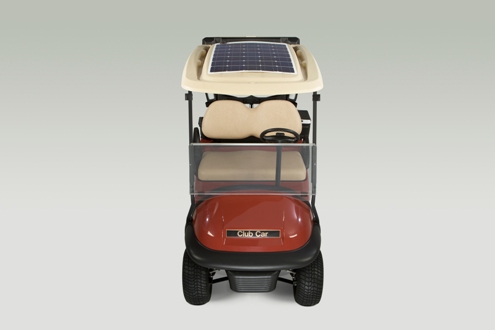Owners of 48-volt electric Club Car Precedent golf cars, Carryall utility vehicles and Villager LSVs can now capture, store and use solar power with the addition of Club Car’s new 100-watt Solar Drive Charging Panel Assembly.
As a yearly average, the system generates 29 percent of the total energy required to drive eight miles per day in West Palm Beach, FL. That reduces the energy needed to recharge the battery by 29 percent. Results may vary depending on area and usage.
By continually transferring energy to the batteries, the panels limit how deep into the battery reserve a vehicle must go during a typical use.
These high-quality panels are based on technology developed for the U.S. Marine Corps, which uses it to run communications equipment in the Middle East.
The panels are made in the United States of a lightweight, impact-resistant, photo-voltaic material with a Teflon-like coating that protects the cells.
Measuring 40″ x 26″, the panels fit snuggly on the canopies or cabs of Precedent golf cars, Carryall utility vehicles and Villager LSVs. They weigh less than six pounds and are just .20 inches thick.
Most solar panels are made in China, framed in tempered glass and weigh approximately 24 pounds, creating drag on the vehicle and limiting the benefits. What’s more, service and warranty issues can be a big problem with panels made abroad.
“The Club Car panels are designed with advanced power-harvesting technology that optimizes solar power during various weather conditions and rapidly converts it into electricity to recharge the batteries and power vehicles,” says Crook. “The system also features an intelligent microprocessor that allows a higher rate of charge and reduces charge time, without overheating.”
The panels come complete with a controller, connector to the vehicle’s power supply, all necessary hardware and installation instructions. They can be user- or dealer-installed in about 20 minutes.
In addition to the standard 100-watt panel for the above-mentioned vehicles, Club Car can configure solar panels for other types of vehicles through its Custom Solutions Department.
Utility vehicles, by definition, are often used in wet, hilly and rough terrain. But this can cause problems with traction for many two-wheel drive models.
That’s not the case with Club Car’s new line of Carryall utility and transport vehicles. They are now available from the factory with an optional automatic limited slip differential (LSD) when ordered with the class-leading EFI powertrain.
“This innovative system improves hill-climbing ability and traction for our Carryall utility vehicles and Transporter™ and Villager™ transport vehicles, especially in rough terrain or weather,” says Commercial Marketing Manager Kimber Parrish.
Club Car’s automotive-style LSD system operates differently – and more effectively – than either open or locking differentials.
Vehicles with locking differentials lock up completely and damage turf in a turn. They can also lock at the wrong times. While they may be fine for extreme off-road applications, they are rough on lawns and grass.
What’s more, manual locking differentials require operators to pull a lever and lock the differential. “Yet drivers can get stuck before they realize it. They may also forget to unlock, which will further damage turf,” Parrish says.
Open differentials, on the other hand, are simpler in design and function than limited slip systems. But when these vehicles get stuck, the power is transferred to the tire with the least traction, so the tire just keeps spinning.
“Our limited slip system delivers true on-demand traction, without the driver having to manipulate levers or buttons,” say Product Manager, Utility Platform Ross Lyons.
“When driving in a straight line, the system operates like a locking differential where both tires are receiving power for maximum traction. Once you start turning, the internal clutches allow the tires to turn at different speeds, reducing the chance of turf damage,” Lyons says.
“The system was engineered and tuned to work both on turf and off-road. It distributes power effectively, so your crews can get out of sand and mud and back to work,” Lyons says.
“Since our 4x2s are mid- or rear-engine vehicles, most of the weight is on the rear tires. That means the back tires get more ‘bite’, and having weight in the vehicle only increases this,” Parrish says.
All this, coupled with new best-in-class EFI engines, make Carryall utility vehicles ideal for demanding use on moderately rugged terrain such as driving in mud, off-road or on steep grades or wet surfaces.
“These vehicles are great for climbing wet grassy slopes, or even snow plowing with a 4×2. Or, you can add all-terrain tires to the Carryall 550 utility vehicle and have a lifted vehicle that will navigate rougher terrain like construction sites and unimproved areas,” Parrish says.


